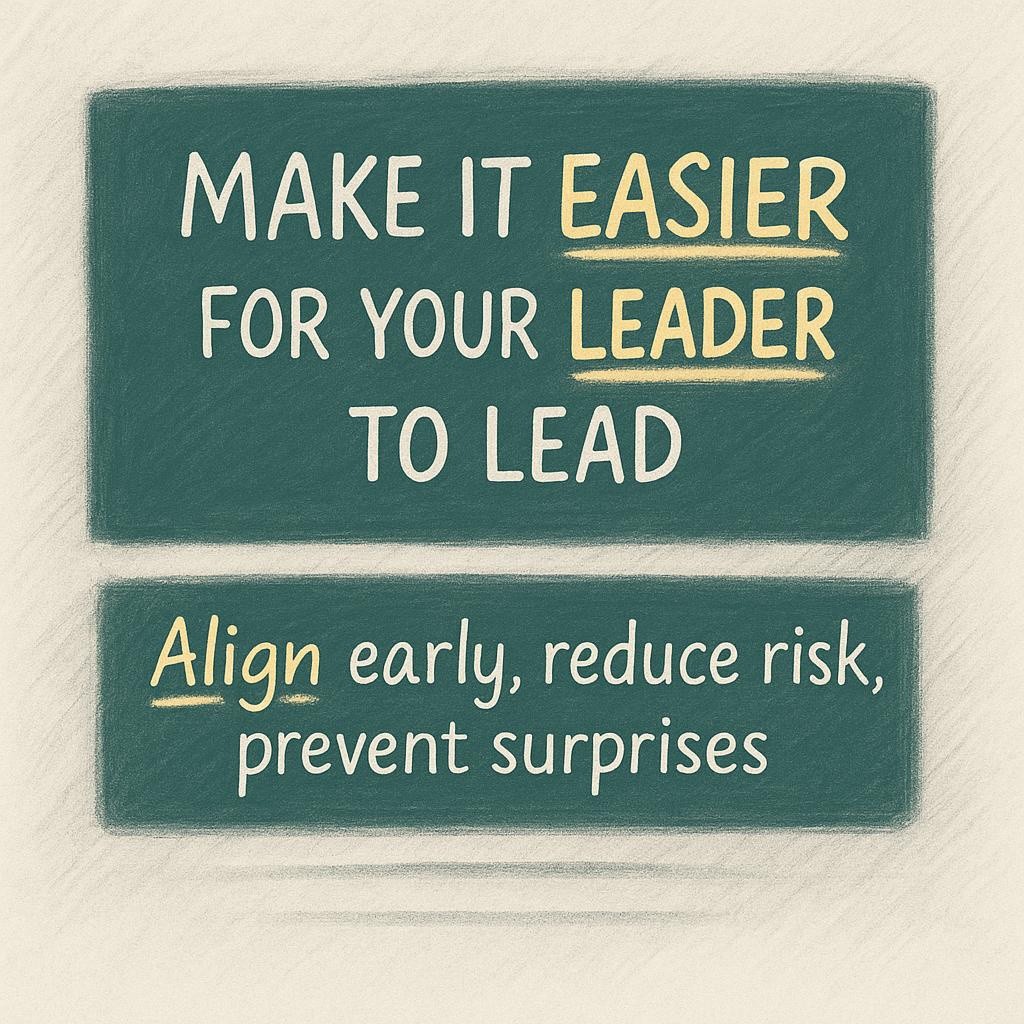Strategic Support: Redefining Managing Up
A VP slid a sticky note across the table. Three words. Reduce board surprises. No lecture, no blame, just a quiet ask. I spent the week trying to look sharp with long emails, loud slides, and careful phrasing. None of it hit the point.
What did? A simple rhythm. A Monday heads up, a midweek risk check, and a Friday note with two lines: what changed, what I need. The VP did not cheer or high five. She just breathed easier. That was the moment it clicked for me. Managing up is not about me, it is strategic support.
Nancy Vepraskas names this shift in The Leadership Journey. She even says she prefers “Strategic Support” over “Managing Up,” since the old phrase can sound manipulative. The goal is to focus on what senior leaders need so the organization can thrive. “The goal is to create organizational success,” and when the company wins, our teams also win .
What Strategic Support Really Means
When we are new, we want those above us to fix what is broken. As we grow, the question flips. What do they need from me to move our shared purpose forward, through my results, my relationships, and my conduct? Nancy writes that we increase our success when we look up and study our leaders’ goals, pressures, and blind spots, then “get smart about it.” This is not about trying to please, it is about serving the work that matters most to the mission .
Here is the hidden truth. The real work is to remove pressure where it counts. That looks like four simple choices:
- Think up, not down. Ask, “What does my leader need?” not “What do I want?”
- Anticipate. “Listen well, ask more, accept often.” Those five words can change a room .
- Communicate like a partner. Share “good news as well as difficult news,” and do not let leaders get surprised when the stakes are high .
- Aim for results together. Treat leaders as partners in outcomes, not obstacles to work around .
A Moment That Changes Everything
A director kept clashing with the CFO. He sent long decks. She wanted three numbers and a risk. He felt dismissed. She felt blindfolded. We tried one change. Before any meeting, he sent a three sentence brief: what is on track, what is at risk, what decision is needed. Two weeks later, she looped him in on board prep. Not because he spoke louder. Because he lowered her risk.
That is the quiet power of strategic support. It builds trust. It calms the room. It gets you invited into the conversations that matter.
The Questions That Build Trust Upward
Nancy gives questions that pull you out of self focus and into shared focus. Use them to see what your leader sees, then act on it.
- “Can you clearly articulate what your boss or the Board is asking of the company?” If not, ask until you can. Write it down in their words .
- “Where can you release pressure?” Find one place this week, then do it quietly and well .
- “Think up, not down.” Match their communication style, timing, and detail so they can lead without surprise .
- “What would your boss consider a good results oriented collaboration?” Design your updates and asks around that answer .
Your Brand Makes It Stick
Strategic support only holds if people trust you. Nancy says, “We often judge ourselves by our intentions. Others judge us by our actions.” That is your brand, one choice at a time . When others experience you as a “clear thinker, strong communicator, and trustworthy partner,” you get invited into the work that matters, including strategy and complex problems. The higher your clarity, the wider your invitation .
Here is a small practice that grows big results. Choose seven words you want to be known for. Then align your behavior to those words, every meeting and email. Brand is not a slogan. It is how you show up, especially under pressure .
How To Practice Strategic Support This Week
Here is how you do it. Keep it simple and steady.
- Monday, ask one question: “What would make this week a win for you?” Write down the answer where you can see it daily. Act on it by Wednesday .
- Midweek, send a short update that fits their style: what is on track, what is at risk, what you recommend. Include good news and hard news, no surprises .
- Friday, close the loop in two lines: what moved forward, what you will tackle next. Ask, “Anything you want me to adjust?” Then listen well, ask more, accept often .
If you are not sure how your leader likes updates, ask directly. Then align your approach so “key information” lands the way they can use it fast and well .
A Bonus Move That Changes Your Trajectory
Use your seat near senior leaders to learn. Ask for a short debrief after a big meeting. Questions like, “What would you have looked for in that decision?” or “What did I miss that matters next time?” This is how you keep growing your value every month. “Seek opportunities to learn from your superiors,” and keep up with the skills your role really demands .
The One Shift That Changes Everything
Stop trying to impress your boss. Start making it easier for them to lead.
Nancy sums it up with a clear aim. Become “a trusted ally who is seen as an extension of [your leader’s] vision and leadership,” and you foster mutual success for the whole organization .
One last question to carry into your week: What is the one pressure you can quietly remove for your leader, and how will you prove it with your actions on Friday?
